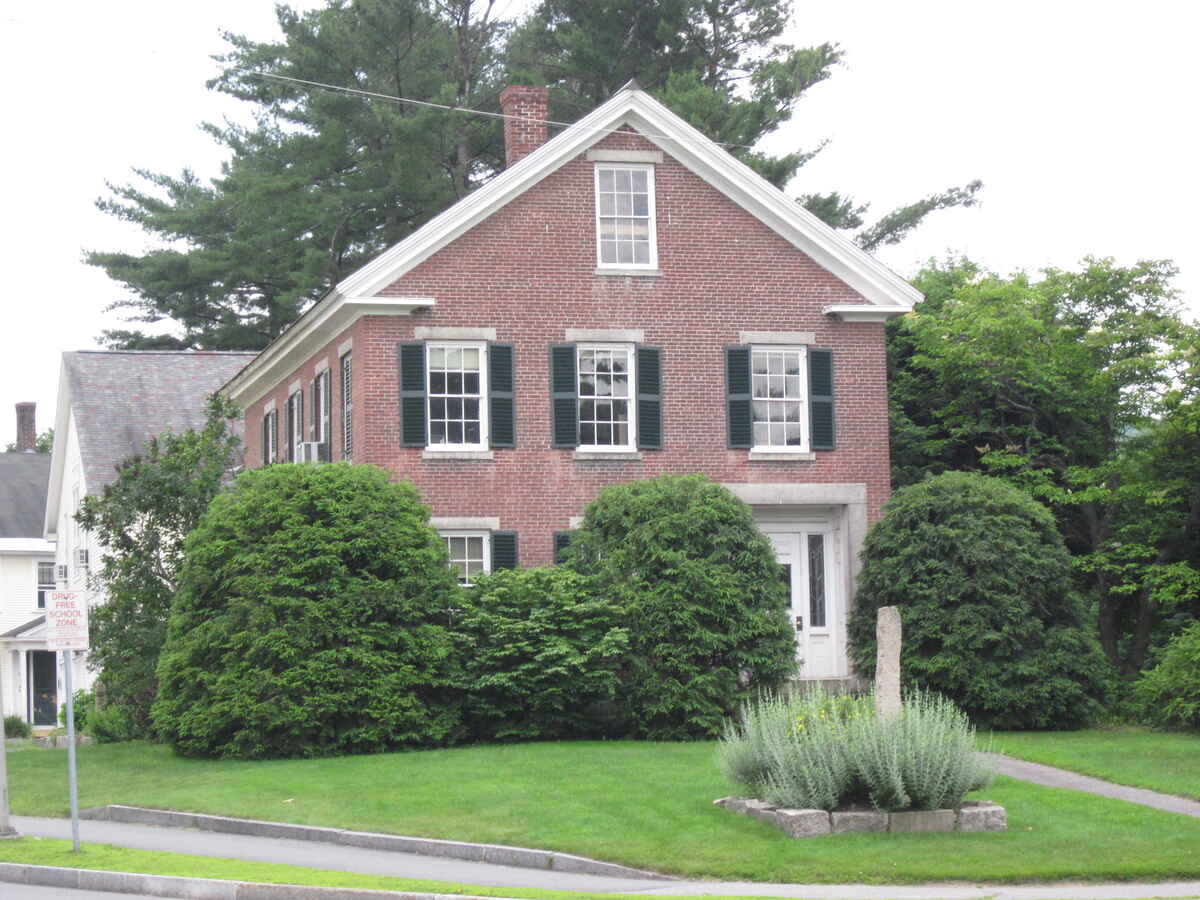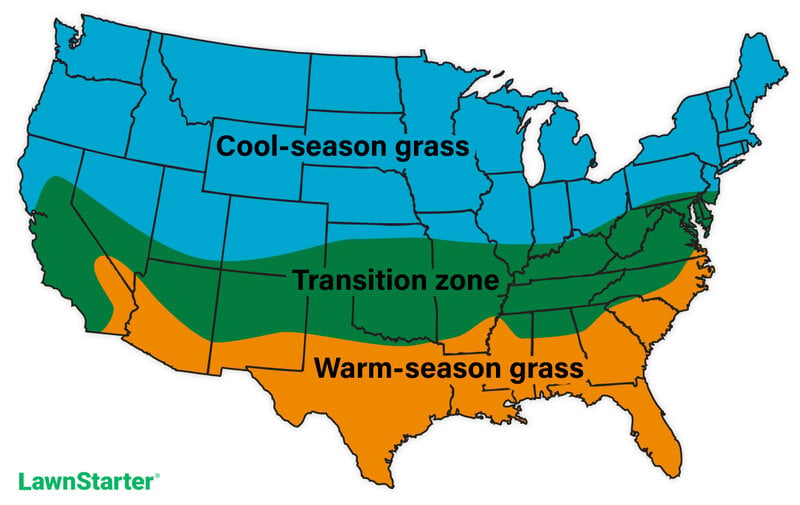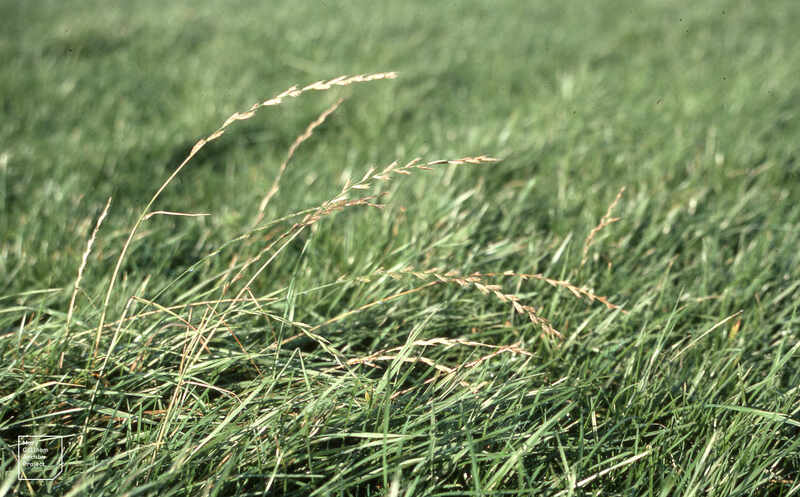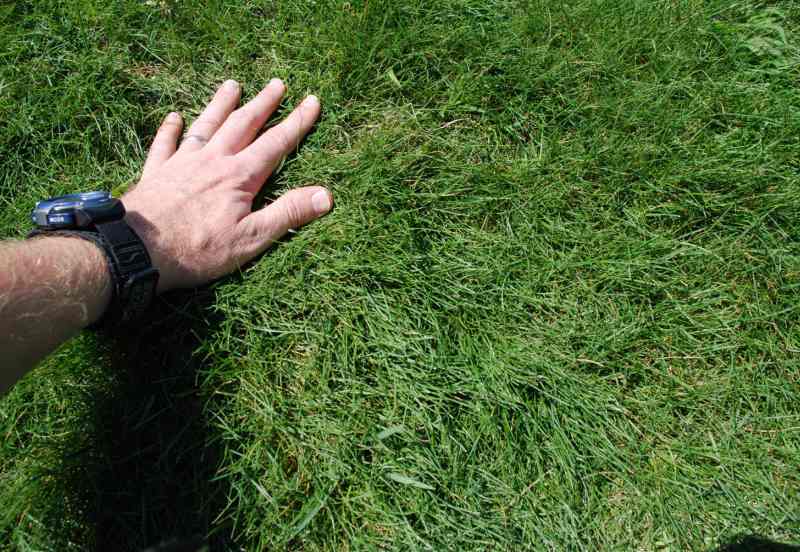
Nestled in the heart of New England, New Hampshire is a charming state known for its picturesque towns and vast areas of untouched wilderness. Because of New Hampshire’s location in the northeast, cool-season grasses thrive there, but what is the best grass seed for New Hampshire?
The state’s northern region boasts the White Mountain National Forest, a popular destination for winter sports enthusiasts. For a fun adventure in the south, consider the scenic Cape Ann self-guided driving tour in Gloucester and Rockport, featuring charming coastal towns. Keep reading to discover how to improve your own bit of New Hampshire scenery with new grass.
If you’re too busy soaking up the coastal views, check out how to choose the best grass seed for your New Hampshire lawn for a quick guide.

Kentucky Bluegrass

Photo Credit: Shutterstock
This high-quality turf grass has a deep blue-green color, fine texture, and dense growth pattern. However, it requires a lot of maintenance, including regular fertilization and watering, and is best suited for lawns with loamy soil and total sun exposure. While it may not be as drought-resistant as other grass species, it can thrive with proper irrigation during hot summer months and dry spells.
Classification: Cool-season grass
Spreads by: Rhizomes
Shade tolerance: Low
Drought tolerance: Moderate
Foot traffic tolerance: Moderate
Maintenance needs: Moderate mowing frequency, and high fertilization needs.
Mowing height: Will tolerate various mowing heights, with 2 inches preferred in most home lawns.
Potential for disease: Moderate to high; prone to several diseases, such as dollar spot, leaf spot, necrotic ring spot, summer patch, and stripe smut.
Soil pH: 6-7.5
Soil type: Performs best in well-drained, heavy soils with high fertility.
Other notes: Needs at least 4 hours of sun daily, but does best under full sun.
Grass Seed Options:
– Jonathan Green (11970) Blue Panther Kentucky Bluegrass Grass Seed (3 lbs.)
– SeedRanch Midnight Kentucky Bluegrass Seed (5 lbs.)
Perennial Ryegrass

Photo Credit: Dr Mary Gillham Archive Project / Flickr / CC BY 2.0
Perennial ryegrass is a popular choice among homeowners due to its fast germination and vibrant, dark-green color. However, its usage varies depending on the region. In the northern parts of the country, it is commonly used as a permanent lawn option. At the same time, in the southern U.S., it is preferred for its ability to provide temporary winter color.
Classification: Cool-season grass
Spreads by: Has a bunch-type growth habit
Shade tolerance: Low
Drought tolerance: Low
Foot traffic tolerance: High
Maintenance needs: Moderate mowing and fertilization requirements. Thatch is not significant.
Mowing height: Generally withstands various mowing heights, but 2 inches is recommended. Sharp mower blades are required.
Potential for disease: High. Common diseases include gray leaf spot, red thread, and leaf spot/melting-out.
Soil pH: Can grow in soils with a pH between 5 and 8, but prefers between 6 and 7.
Soil type: Prefers good drainage and fertility but can tolerate some poor drainage.
Other notes: Is often used in seed mixes with Kentucky bluegrass and fine fescues.
Grass Seed Options:
– Outsidepride Perennial Ryegrass Seed (5 lbs.)
– Eretz ProTurf Perennial Ryegrass Fine Lawn Seed (choose your size)
Tall Fescue

Aaron J. Patton, Ph.D. / Turfgrass Extension Specialist at Purdue University
Initially considered a weed, tall fescue is highly tolerant of heat and drought, making it a great choice for areas in southern New Hampshire. In addition, this cool-season grass can withstand heavy foot traffic, compacted soils, and requires less nitrogen than other cool-season turf grasses.
Classification: Cool-season grass
Spreads by: Produces short rhizomes but has a bunch-type growth habit
Shade tolerance: Moderate
Drought tolerance: Moderate to High
Foot traffic tolerance: Moderate
Maintenance needs: Frequent mowing. Does not produce significant thatch.
Mowing height: Set mowing height to 2 inches when the grass reaches 3 inches tall.
Potential for disease: Tolerant of most diseases when properly maintained.
Soil pH: 5.5-6.5
Soil type: Adapted to a wide range of soil conditions but prefers fertile clay soils with good drainage.
Other notes: Tall fescue grass is often mixed with 20 percent Kentucky bluegrass in a sunny, low-maintenance seeded lawn. Look for improved “turf-type” tall fescue cultivars for the best performance.
Grass Seed Options:
– Triple-Play Tall Fescue Grass Seed Blend (5000 sq ft)
– Eretz Kentucky 31 K31 Tall Fescue Grass Seed (choose your size)
– Pennington The Rebels Tall Fescue Grass Seed Mix (7 lb.)
Fine Fescue

Aaron J. Patton, Ph.D. / Turfgrass Extension Specialist at Purdue University
Fine leaf fescues have the finest textured leaf blades among the cool-season grasses. Depending on the species, they are highly adapted to thrive in shaded areas, withstand extreme temperatures and drought, and don’t require excessive fertilization.
Classification: Cool-season grass
Spreads by: Creeping red fescue spreads by rhizomes, while other fine fescues are bunch-type grasses, such as Chewings, hard, and sheep fescues.
Shade tolerance: Moderate to High, depending on species
Drought tolerance: Moderate to High, depending on species
Foot traffic tolerance: Low to Moderate, depending on species
Maintenance needs: Low fertilizer and mowing needs
Mowing height: Set mowing height at 2 to 3 inches
Potential for disease: Moderate. Common diseases include red thread, leaf spot, dollar spot, summer patch, and powdery mildew.
Soil pH: 6-6.5
Soil type: Must have good drainage. It will tolerate infertile soils, and sandy soils generally work well.
Other notes: It is common to include fine fescues in a lawn seed mix with Kentucky bluegrass for shady/sunny areas. Fine fescues like the shade, while Kentucky bluegrass thrives in the sun.
Grass Seed Options:
– Outsidepride Legacy Fine Fescue Grass Seed (5 lbs.)
– Eretz Creeping Red Fine Fescue Seed (choose your size)
– Outsidepride Creeping Red Fine Fescue Grass Seed (25 lbs.)
– Outsidepride Hard Fine Fescue Grass Seed (10 lbs.)
Seed Mixes
When creating a lush and healthy green lawn, using seed mixes is a popular choice in New England. These seed mixtures typically include a combination of cool-season grasses, such as Kentucky bluegrass, perennial rye, and fine or tall fescues. These grass seed mixes increase resilience (diseases that can attack one grass will probably not attack another).
Tip: A great example of a seed mixture for a shady lawn (less than 4 hours of sun per day) is 70% fine fescue, 20% perennial ryegrass, and 10% Kentucky bluegrass (shade variety).
How To Choose The Best Grass Seed For Your New Hampshire Lawn
When selecting cool-season grasses, it’s important to consider the growing conditions in your landscape. These factors all play a role in determining which type of grass seed best suits your lawn:
- The site
- Soil drainage
- Soil type
- Sun
- Shade
By taking the time to consider the site’s conditions, you can save yourself time, effort, and money in the long run.
Shade Tolerance
Shade can be a major challenge to maintaining a healthy and vibrant lawn. Grasses typically have a hard time growing where there is lots of shade, which will negatively impact their overall health and appearance. These cool-season grasses below will help you choose based on your site conditions for shade.
Low shade tolerance: Kentucky bluegrass, perennial ryegrass
Moderate shade tolerance: Tall fescue
High shade tolerance: Fine fescue
Drought Tolerance
Believe it or not, New Hampshire often experiences drought. The New Hampshire Department of Environmental Services states, “Between 2000 and 2020, drought conditions occurred within 11 of those 20 years.” Water restrictions are often implemented when drought happens, so choose a grass seed with some drought tolerance.
Low drought tolerance: Perennial ryegrass
Moderate drought tolerance: Kentucky bluegrass, tall fescue
High drought tolerance: Fine fescue
Foot Traffic Tolerance
Lawns are designed to be enjoyed, but they can also take a beating from regular use, such as mowing, playing, and pets. However, excessive wear and tear can cause lasting damage to your lawn and also cause bare spots. If this describes your lawn, choose a grass seed suited for high traffic areas.
Low traffic tolerance: Fine fescue
Moderate traffic tolerance: Kentucky bluegrass, tall fescue
High traffic tolerance: Perennial ryegrass
Maintenance Needs
Some homeowners can’t wait for a free day when they can immerse themselves in “everything lawn.” But if you are like most homeowners who would rather spend your precious time elsewhere, check out this grass seed maintenance list.
Low maintenance needs: Fine fescue
Moderate maintenance needs: Perennial ryegrass, tall fescue
High maintenance needs: Kentucky bluegrass
Call In The Pros
Looking for a New Hampshire lawn care pro near you? We have trusted Lawnstarter lawn care pros in Manchester, Nashua, Portsmouth, Rochester, and other cities across New Hampshire. Give us a call and let a local pro handle your mowing, bush trimming, aeration, overseeding and other lawn care chores throughout the growing season.
Main Image Credit: Doug Kerr / Flickr / CC BY-SA 2.0
LawnStarter participates in the Amazon Services LLC Associates Program, an affiliate advertising program. LawnStarter may earn revenue from products promoted in this article.